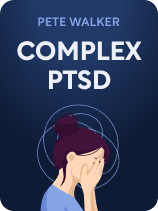

This article is an excerpt from the Shortform book guide to "Complex PTSD" by Pete Walker. Shortform has the world's best summaries and analyses of books you should be reading.
Like this article? Sign up for a free trial here.
Can mindfulness help people with PTSD? What’s the best way to develop mindfulness if you’ve experienced trauma?
Trauma and mindfulness are linked in that practicing mindfulness can aid healing. Mindfulness requires understanding yourself in an accepting way, which is critical for those with trauma, and especially for survivors of abuse.
Read more for an explanation of why mindfulness can help and how to meditate for mindfulness if you have a history of trauma.
How to Cultivate Mindfulness
Developing a healthy sense of self eventually leads to mindfulness: the capacity to understand and accept yourself as you currently are. Phrased differently, mindfulness is the combination of comprehension and compassion. Practicing mindfulness helps people to observe their moment-to-moment thoughts and impulses, identify them, and rationally decide how to respond to them. Trauma and mindfulness are related; observing thoughts and impulses like this can help survivors of trauma reframe their experiences and begin healing.
(Shortform note: This explanation of mindfulness is a bit different from its usual meaning, which involves awareness but not necessarily compassion. In Radical Acceptance, psychologist Tara Brach defines mindfulness as recognizing and understanding one’s moment-to-moment thoughts, emotions, and physical sensations without feeling compelled to act on them. For instance, a mindful person might recognize that they feel uncomfortable in a social situation, but not feel like they need to escape from that situation immediately—they can first consider why they feel uncomfortable, then make a rational choice about whether to stay or go. Note that Brach does consider self-compassion to be part of a healthy mindset, she just doesn’t include it as part of mindfulness.)
Mindfulness is a crucial skill for people with PTSD to develop. This is because mindfulness will allow them to recognize which thoughts come from their overactive self-judgment and which are actually appropriate for the current situation. Mindfulness will also allow them to make rational, healthy decisions about what to do, instead of impulsively reacting to their fears of punishment or abandonment.
For example, someone who’s being treated unfairly at work might experience the feeling of shame and the belief that it’s their own fault. By practicing mindfulness, they could recognize that those are trauma-induced thought patterns and that anger would be a justified, healthy response to such unfair treatment. They could then make the rational decision to report the situation to HR.
| Mindfulness Meditation The traditional way to develop mindfulness is by practicing meditation. Mindfulness meditation trains practitioners to calmly observe their own internal processes; to recognize what they’re thinking and experiencing without impulsively reacting to it. This practice helps them to take calm, rational action in any situation, instead of blindly following their impulses. As Buddhist monk Bhante Gunaratana writes in Mindfulness in Plain English, mindfulness meditation involves sitting quietly and focusing completely on one thing, such as breathing. Distractions are bound to arise, like extraneous thoughts or sounds from outside, but each time the practitioner gets distracted they gently guide their focus back to their breath. Importantly, they should recover their focus without criticizing themselves for getting distracted, and without getting upset at whatever distracted them. For example, if someone hears a car horn while meditating, they should simply acknowledge what they heard and go back to meditating—they shouldn’t pass judgment on themselves or on the car, nor should they get up and close the window to block out the sound. With time and experience the practitioner will find that they get distracted much less frequently, and if they do get distracted, it’s much easier to regain their focus. This is a sign that they’ve gotten better at understanding themselves and have begun to separate experiencing something from reacting to it. |

———End of Preview———
Like what you just read? Read the rest of the world's best book summary and analysis of Pete Walker's "Complex PTSD" at Shortform.
Here's what you'll find in our full Complex PTSD summary:
- A guide to recognizing Complex Post-Traumatic Stress Disorder
- How to recover using physical, psychological, emotional, and social healing
- Why it's so important to accept and appreciate things that are "good enough"






